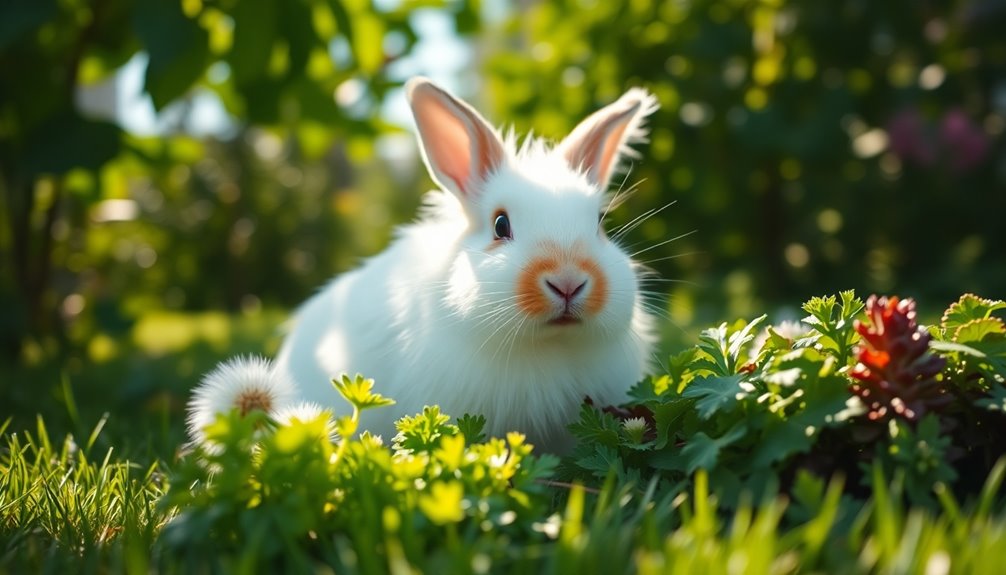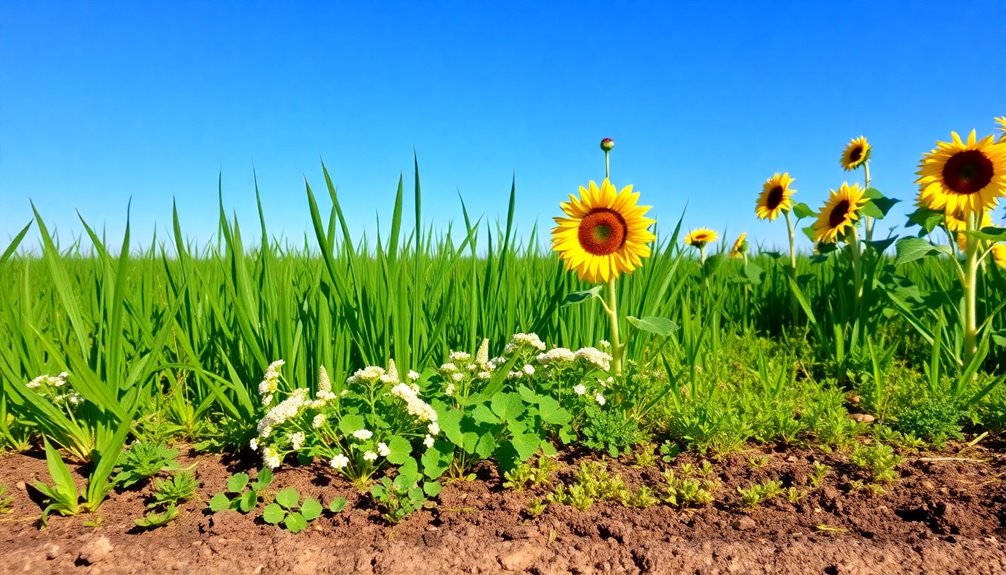For your rabbit's happiness and health, forage is key. Aim for 80-90% of their diet to be high-quality hay, like timothy or orchard grass. One rabbit-sized bundle of hay daily is ideal, but adjust this based on your bunny's weight and activity level. Fresh vegetables should make up 10-15% of their intake, with about 1 cup per 2 lbs. Avoid alfalfa hay for adults, as it can cause health issues. Keep an eye on their hydration and weight. Understanding these guidelines will guarantee your furry friend thrives, and there's more to uncover about best feeding!
Key Takeaways
- Forage should make up 80-90% of a rabbit's daily diet for optimal health and digestive function.
- Offer at least one rabbit-sized bundle of high-quality hay daily, adjusting based on individual needs.
- Choose grass hay varieties like timothy, orchard grass, or brome for essential fiber and nutrition.
- Monitor your rabbit's body condition to ensure they maintain a healthy weight and adjust hay portions as necessary.
- Always provide fresh water alongside forage to prevent dehydration and support overall health.
Importance of Forage in Rabbit Diet

For rabbits, forage is essential, making up 80-90% of their diet and ensuring they get the necessary fiber needed for digestive health. Providing unlimited access to high-quality hay, such as timothy, orchard grass, or brome, is important for supporting your rabbit's natural grazing behavior.
These hays not only help maintain a healthy digestive system but also prevent obesity by keeping your rabbit satisfied without overindulging in high-calorie treats. You should offer at least one rabbit-sized bundle of hay daily to promote proper digestive function.
This routine also encourages dental health by allowing your rabbit to naturally wear down their continuously growing teeth. Incorporating a variety of hay types enriches mealtime, preventing picky eating and enhancing your rabbit's mental stimulation.
Regular hay consumption leads to better health outcomes, greatly reducing the risk of gastrointestinal issues. When you prioritize forage in your rabbit's diet, you're contributing to a happier, more active lifestyle.
Daily Forage Requirements
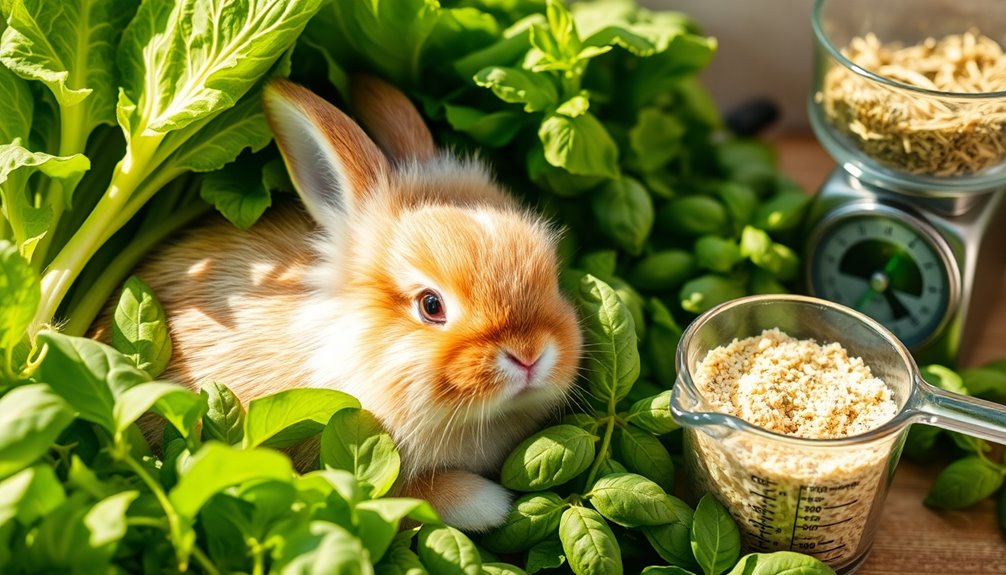
Providing your rabbit with the right amount of forage each day is essential for maintaining their health. You should guarantee they have an unlimited supply of high-quality hay, which should make up 80-90% of their daily diet. On average, one rabbit-sized bundle of hay per day is ideal, so replenish it regularly as it runs low.
For an added nutritional boost, consider the following guidelines:
| Rabbit Body Weight | Recommended Hay Amount | Recommended Vegetable Intake |
|---|---|---|
| 2 lbs | 1 bundle | 1 cup |
| 4 lbs | 1 bundle | 2 cups |
| 6 lbs | 1 bundle | 3 cups |
| 8 lbs | 1 bundle | 4 cups |
It's essential to monitor your rabbit's body condition and adjust forage amounts, especially for older or less active rabbits. A variety of greens can help maintain a balanced diet. And don't forget, fresh water should always be available to keep your rabbit hydrated and support overall health!
Types of Hay for Rabbits
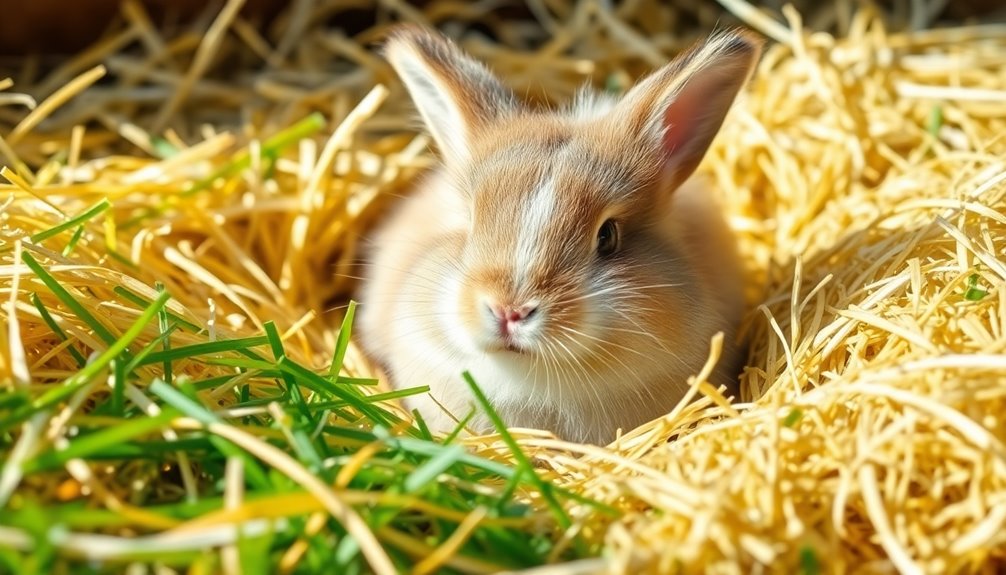
When it comes to your rabbit's diet, grass hay varieties like timothy, orchard grass, and brome are essential.
These hays not only make up the bulk of their nutrition but also provide important benefits for their digestive health.
Grass Hay Varieties
Many rabbit owners find that incorporating a variety of grass hays into their pets' diets can greatly enhance their overall health. One of the most common types you'll want to provide is Timothy hay, known for its high fiber content that supports digestive health and helps prevent obesity. It's a staple in many rabbit diets.
Orchard grass hay is another excellent option; its softer texture is often favored by rabbits, making it a delightful addition to their forage.
If you're looking for something versatile, consider brome hay. It's high in fiber and can serve as a great substitute or complement to Timothy and Orchard grass hays.
For those picky eaters, oat hay can be a game changer. Made from the seed heads of oat grass, it's flavorful and packed with fiber, making it appealing to even the most finicky rabbits.
Just remember to steer clear of alfalfa hay for adult rabbits, as its high protein and calcium content can lead to health issues if fed regularly.
Nutritional Benefits of Hay
Hay serves as the cornerstone of a rabbit's diet, delivering essential nutrients that promote overall health. You should aim to have hay make up 80-90% of your rabbit's daily intake. The high fiber content in hay supports digestive health and helps prevent obesity, ensuring your furry friend stays happy and healthy.
Timothy hay is often the best choice for adult rabbits due to its balanced nutritional profile. It encourages proper chewing and keeps their teeth in check. To keep your rabbit engaged and satisfied, offer a variety of grass hays, like orchard grass, brome, and oat hay. This variety not only prevents dietary boredom but also encourages healthy eating habits.
If you have a young rabbit, alfalfa hay can be beneficial due to its higher protein content. However, steer clear of alfalfa for adult rabbits, as its richness can lead to unwanted weight gain.
Measuring Portion Sizes
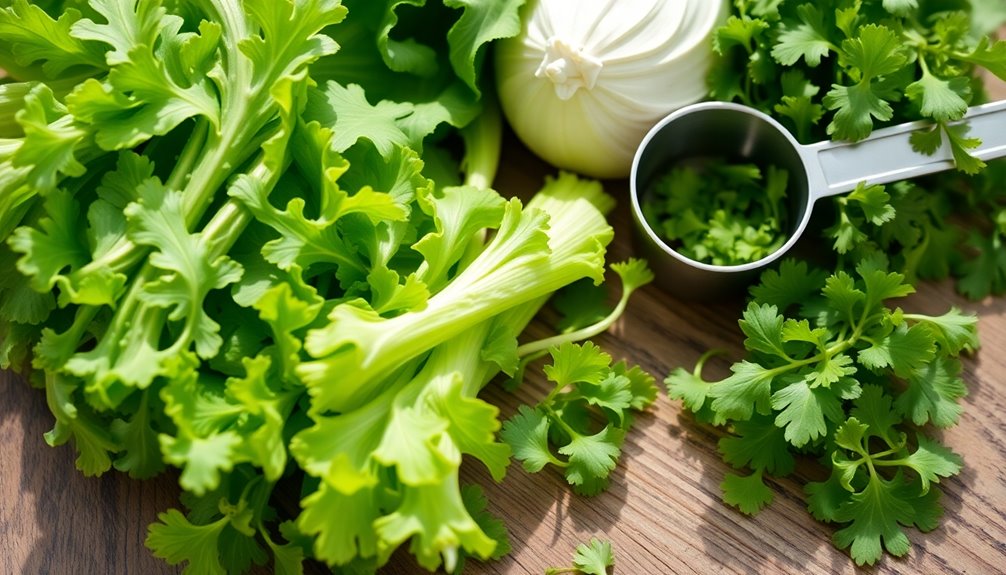
When it comes to measuring portion sizes for your rabbit, daily hay requirements are essential for their health.
You'll want to make sure they get at least one rabbit-sized bundle of hay each day, adjusting based on their weight.
Keeping an eye on portion control guidelines will help you maintain your rabbit's ideal weight and well-being.
Daily Hay Requirements
Providing your rabbit with unlimited access to hay is essential for their health, as it should make up 80-90% of their diet. Your rabbit's daily hay requirements can be met by offering at least one rabbit-sized bundle of fresh hay each day. This helps support their gastrointestinal system and prevents obesity, which is critical for small herbivores like rabbits.
Different types of grass hay, such as timothy, orchard grass, and brome, offer nutritional variety and keep your rabbit from becoming picky. Regularly replenishing hay supplies guarantees your rabbit can graze continuously, promoting a healthy weight and aiding in dental health through natural wear.
Monitoring your rabbit's hay consumption is significant, as it plays a major role in their overall wellness and vitality. If you notice a decrease in their intake, it could indicate health issues or a preference for a different type of hay.
Always provide fresh hay and be attentive to your rabbit's habits to maintain peak health. By meeting their daily hay requirements, you'll contribute to a happy, healthy bunny that thrives in your care.
Portion Control Guidelines
Maintaining a balanced diet for your rabbit goes beyond just providing hay. While hay should make up about 80% of their diet, you also need to manage portion sizes carefully to keep your bunny healthy.
To calculate the daily food ration, aim for 25 grams of food per kilogram of your rabbit's body weight, dividing this into two meals.
For fresh vegetables, they should account for 10-15% of your rabbit's daily intake. A good rule of thumb is to offer about 1 cup of veggies for every 2 pounds of body weight.
Remember, variety is key when it comes to vegetables, so mix it up to keep your rabbit interested and healthy.
When it comes to pellets, limit them to 1/4 cup per 5 pounds of body weight to prevent nutritional imbalances and obesity.
Keep an eye on your rabbit's body condition score and adjust portion sizes as necessary. Conduct bi-weekly weight checks to guarantee your furry friend stays in peak health.
Adjusting Portions for Individual Needs
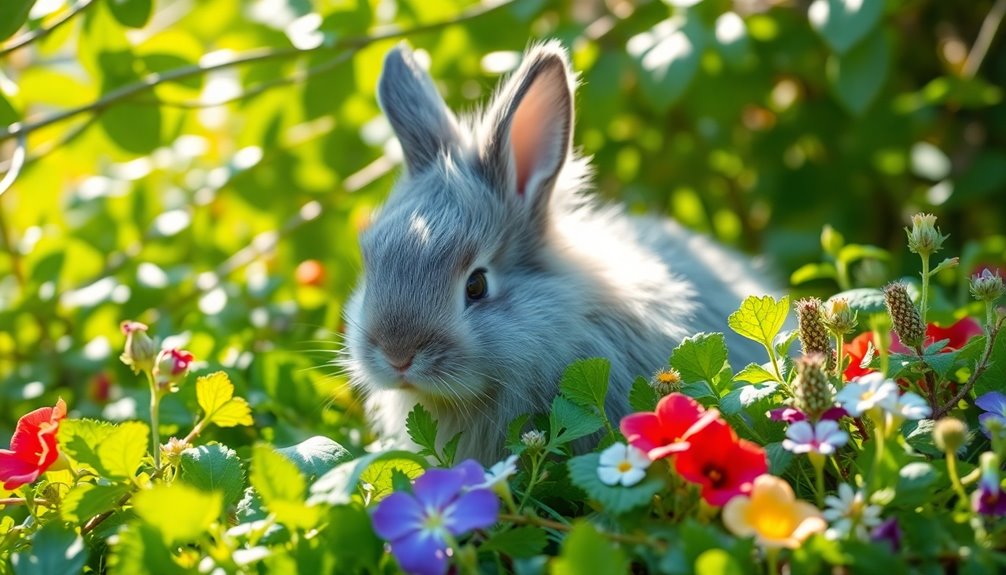
Adjusting portions of forage for your rabbit is essential, especially since each bunny has unique needs based on factors like weight, age, and activity level. To determine the right amount, use the guideline of 25g of forage per kg of body weight daily.
Remember, hay should make up about 80% of your rabbit's diet, guaranteeing proper digestive health and preventing obesity.
When adjusting portions for individual needs, consider your rabbit's age, breed, and health status. For instance, senior or sedentary rabbits may require smaller portions to avoid excess weight gain.
Regularly monitor your rabbit's body condition score; you want to aim for a healthy weight where ribs aren't visible.
It's also important to gradually introduce and adjust different types of forage to keep your bunny interested and prevent picky eating.
A varied diet of grass hays not only promotes overall well-being but also aids in proper forage intake. By paying close attention to these factors, you can guarantee your rabbit receives the right amount of forage, tailored specifically to their individual needs.
Signs of Proper Nutrition
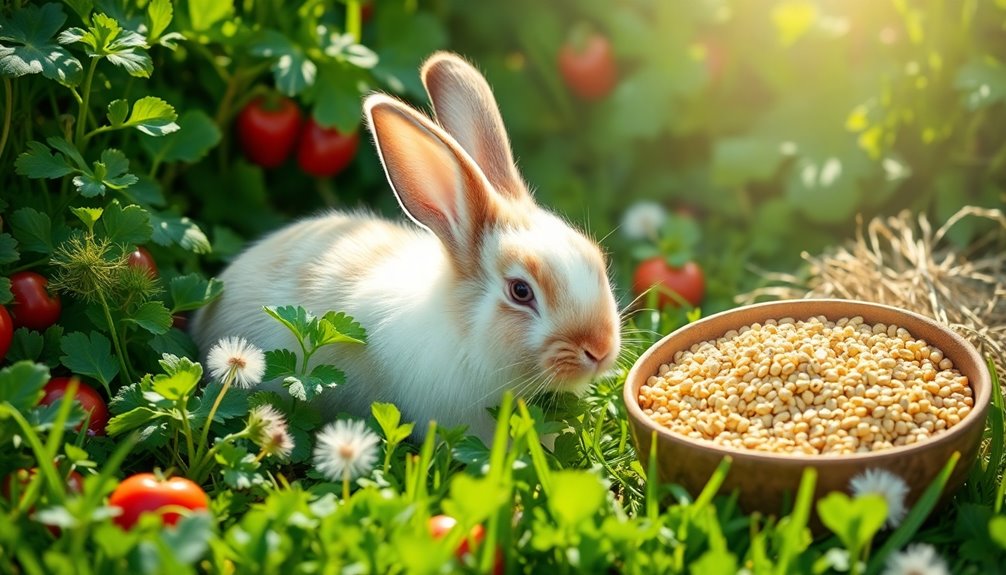
Proper nutrition in rabbits can be identified through several key indicators. When your bunny's diet is on point, you'll notice these signs:
- A shiny, smooth coat that reflects their overall health
- Consistent energy levels and playful behavior
- Normal, firm, round droppings that indicate a fiber-rich diet
A healthy rabbit should maintain an ideal body weight, where the ribs aren't visible and there's a slight fat covering. This suggests appropriate weight management and good nutrition.
Additionally, a balanced diet high in grass hays contributes to good dental health, preventing issues like overgrown teeth.
Moreover, proper nutrition strengthens your rabbit's immune system, making them less susceptible to diseases. Regular playfulness and energy levels mean your bunny isn't only happy but also well-nourished.
Keep an eye on these indicators to guarantee your rabbit is thriving. By focusing on high-quality grass hays and maintaining a balanced diet, you'll foster a healthy, vibrant bunny who enjoys life to the fullest!
Common Feeding Mistakes to Avoid
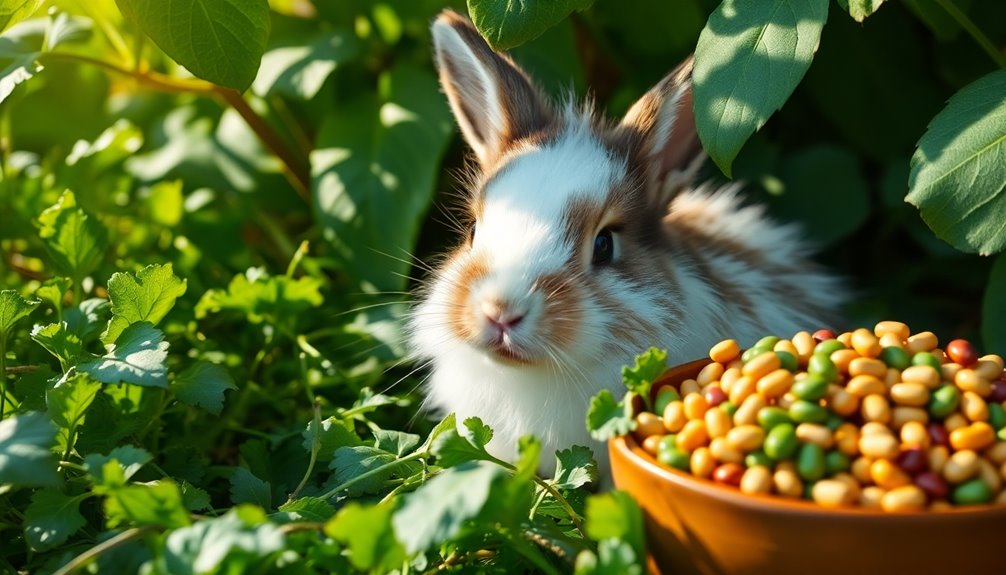
Many rabbit owners unknowingly make common feeding mistakes that can seriously impact their pet's health. One of the biggest errors is relying too heavily on pellets. While they're convenient, pellets should only be a small part of your rabbit's diet, ideally no more than 1/4 cup per 5 lbs of body weight.
Another critical mistake is neglecting hay. Hay should make up 80-90% of a rabbit's diet, and without unlimited access to it, your rabbit may face digestive issues and obesity. Additionally, failing to provide a variety of fresh vegetables can lead to nutrient deficiencies. Aim for about 1 cup of vegetables per 2 lbs of body weight daily.
Proper hydration is equally important. Always guarantee your rabbit has access to fresh water, as inadequate hydration can cause serious health issues. Finally, limit treats to just a few times a week, with a maximum of 1-2 tablespoons of fruit per 5 lbs of body weight.
| Mistake | Consequence |
|---|---|
| Over-reliance on pellets | Nutritional imbalances |
| Lack of hay | Digestive issues, obesity |
| Insufficient veggies | Nutrient deficiencies |
| Poor hydration | Dehydration |
| Too many treats | Disrupted balanced diet |
Frequently Asked Questions
How Much Forage Should a Rabbit Eat?
When considering how much forage a rabbit should eat, remember that hay is essential for their health. You should provide unlimited access to fresh hay daily, aiming for at least one rabbit-sized bundle.
This constant supply helps maintain their digestive system and prevents obesity. It's best to offer a variety of grass hay types, like timothy and orchard grass, to keep your bunny happy and engaged with their diet.
How Much Food Should a Rabbit Eat per Day?
Picture your rabbit nibbling happily on a pile of fresh veggies, surrounded by a cozy bed of hay.
To keep that joy alive, you should feed your bunny around 25 grams of food for every kilogram of their weight daily. Aim for about 80% hay, 10-15% fresh vegetables, and limit pellets to 1/4 cup per 5 pounds.
Check their weight regularly to verify they're thriving and adjust portions as needed.
What Is a Serving Size of Rabbit Food?
When determining a serving size for your rabbit's food, you'll want to focus on their weight.
Generally, aim for 25 grams of food per kilogram of body weight. For adult rabbits, limit pellets to about 1/4 cup for every 5 lbs.
Additionally, provide around 1 cup of fresh veggies daily for every 2 lbs of body weight.
How Much Greens Should a Rabbit Eat per Day?
You should give your rabbit about 1 cup of fresh vegetables for every 2 pounds of their body weight daily.
For smaller breeds, like dwarfs, aim for 1 cup per day.
Remember to include a variety of leafy greens, such as romaine lettuce and parsley, while avoiding starchy veggies like potatoes.
Introduce new greens gradually to guarantee your bunny's tummy stays happy and healthy.
Keeping mealtime interesting is essential for their overall well-being!
Conclusion
In your rabbit's world, lush green hay is like a vibrant meadow, essential for their happiness and health. By ensuring they have the right amount of forage each day, you're crafting a feast that fuels their playful hops and gentle nibbles. Remember to observe their unique needs, adjusting portions like a skilled artist refining their masterpiece. With every bite, you're not just feeding; you're nurturing a bond that thrives on the joy of shared moments in your home.

